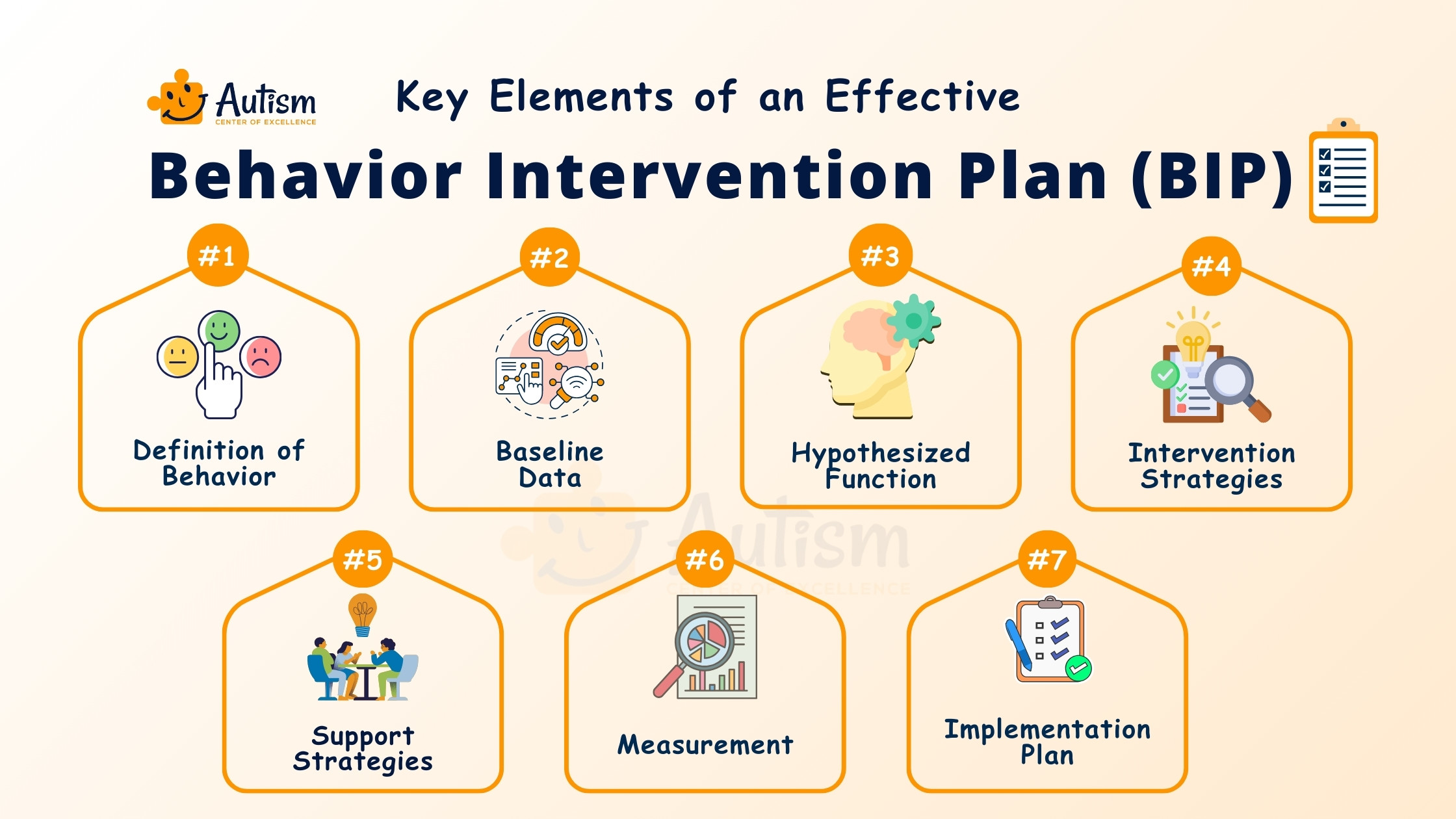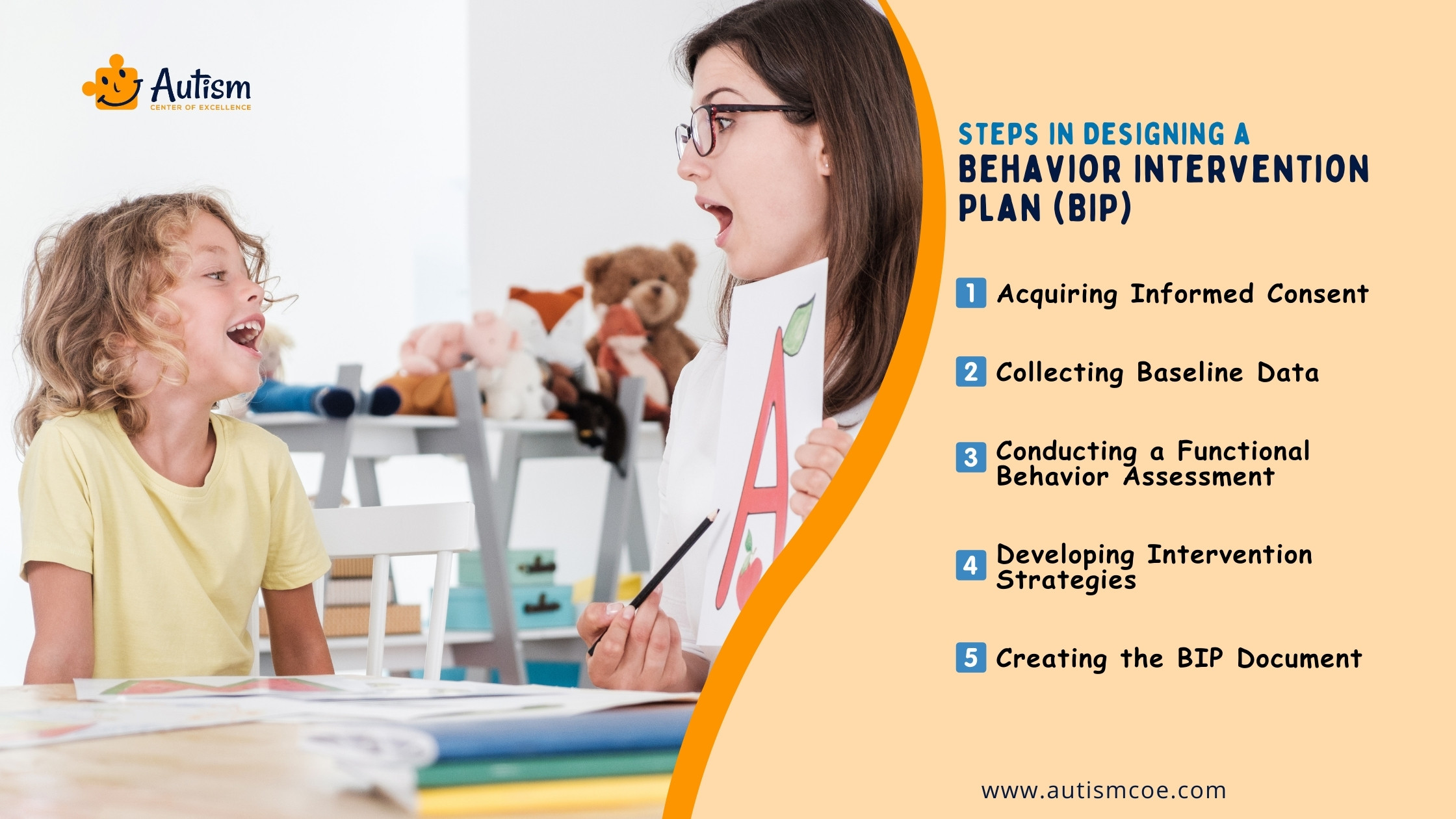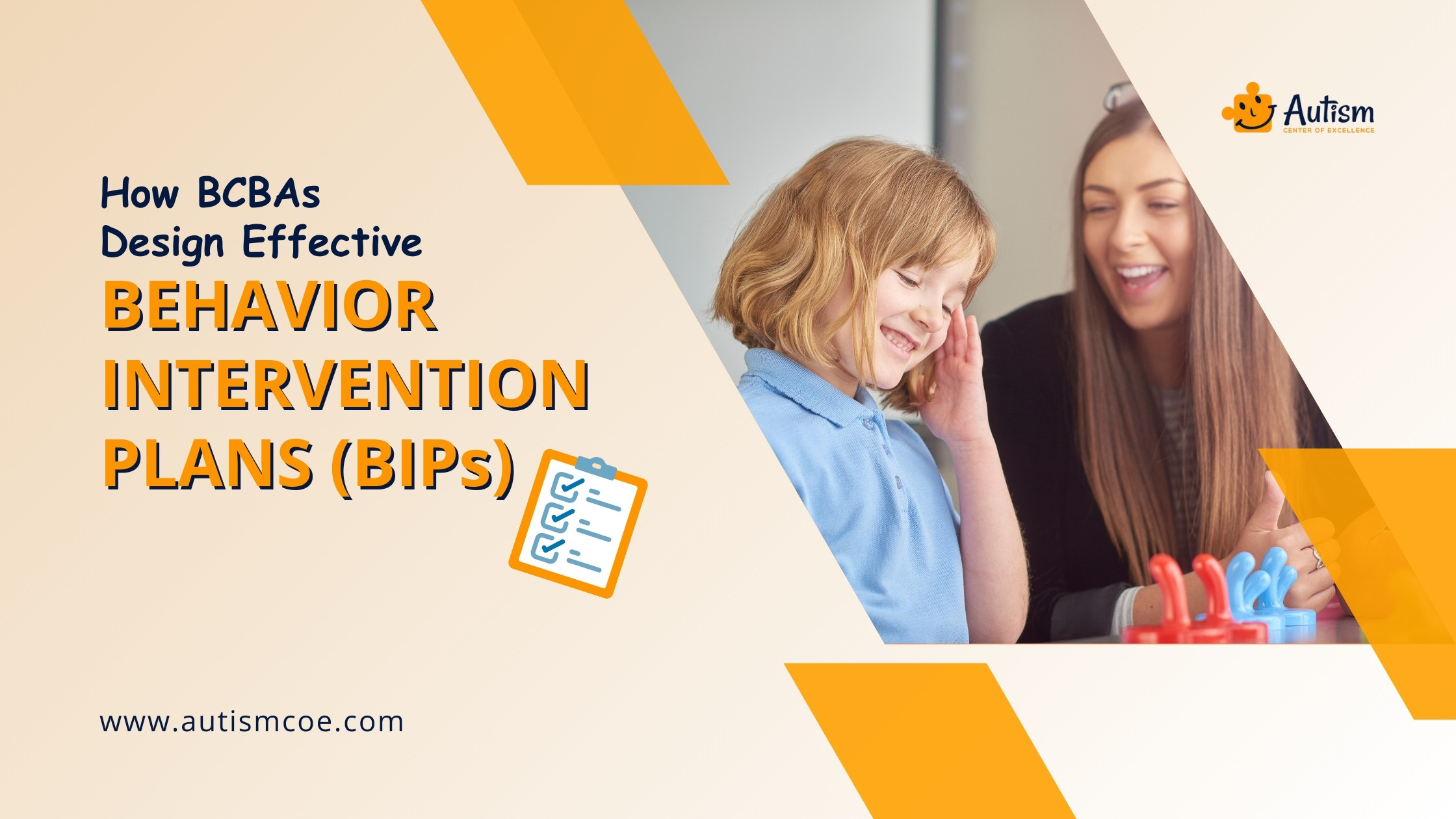Behavior Intervention Plans (BIPs) are indispensable tools for Board Certified Behavior Analysts (BCBAs). These plans are like strategic maps, carefully designed to give directions for the adoption of targeted strategies aimed at improving socially important behaviors. Within the complex process of designing these plans, BCBAs closely evaluate individual requirements, recognize behavior trends, establish measurable objectives, and adapt the interventions to each distinct case. This targeted method ensures that behavior intervention plans are not only successful but also effective for the individual needs of the people for whom they are created.
What is a Behavior Intervention Plan (BIP)?
A Behavior Intervention Plan (BIP) is a written, structured program designed by Board Certified Behavior Analysts (BCBAs) or other behavior analysis professionals. It is meant to eliminate Challenging Behaviors that hamper a person’s learning, social interactions, or conduct in the day to day activities. The BIP comprises a detailed description of the behavior, its theoretical function (reason for why it happens), and methods for minimizing or replacing it with more appropriate ones. It also denotes the person who is to implement the plan and how the progress will be measured. The ultimate goal of a BIP is to improve the quality of life of a person through the promotion of positive behavior change.
Download Our Behavior Intervention Plan Template!
Also, get our weekly newsletters!
Importance of BIP in ABA Therapy for Children with Autism
The Behavior Intervention Plan (BIP) is an important part of Applied Behavior Analysis (ABA) Therapy, especially in children with Autism Spectrum Disorder (ASD). It is a customized map that is adjusted to the specific needs of each person, which guarantees flexibility and adaptability. Continuous monitoring and adjustment are among the core components enabling real-time reactions to advances and setbacks, which, in turn, promote substantial and long-lasting behavioral changes.
It deals with and Reduces Problematic Behaviors, fostering constructive behavior as Effective Communication.
They present a systematic strategy for behavior control with Setting Clear Expectations and Reinforcing Positive Behaviors.
The formulation of a Behavior Intervention Plan for autism is based on functional behavior assessments and Evidence-Based Interventions.
BIPs are the blueprint of behavior change, which provides the direction to the treatment and makes sure of Consistent Responses from All Involved Parties.

The 7 Key Elements of an Effective Behavior Intervention Plan (BIP)
A good BIP is comprised of all the elements and must be tackled in a holistic manner. It involves things such as the specified behavior like the intensity and frequency, the area of the event, and its period. Altogether the details play an important function in creating an effective plan as they show the person’s behavior clearly and its impact on the person’s life. These components are very carefully selected to meet the individual needs and to maximize the efficiency of the intervention.
Definition of Behavior
The first course of action of this plan is to name the problematic behavior that needs to be modified. This definition must be transparent and explicit, enumerating actions or behaviors that are regarded as inappropriate.
Baseline Data
Before any activity can be implemented it is important to know where the behavior stands. This is based on the gathering of information on the number, duration, intensity, and context of the behavior.
Hypothesized Function
Subsequently, the BCBA makes a guess about the right function or cause of the behavior for the given baseline data. It can be anything related to seeking attention, avoiding a tough task, getting a restricted thing or activity, or releasing sensory needs.
Intervention Strategies
Analyzing the effects of the performance, BCBAs formulate interventions to mitigate them. Such may include teaching the children different acceptable behaviors, adjusting the surroundings, showing them some way of responding to the behavior, usually, combine all these.
Support Strategies
In addition to the main approach of Intervention Strategies, BCBAs also tend to focus on supporting strategies. These could be additions to the environment, modifications of the schedule, or training workshops for the teachers or parents.
Measurement
Along with the policies stated, any good BIPs should have a system in place for progress tracking. This could be in the form of continued data gathering, reviewing on a regular basis, or any other kind of evaluation. The success of the intervention cannot be determined without this information.
Implementation Plan
Lastly, the BIP should describe what mechanisms will be used to execute the strategic plan. These are some of the elements that one should be able to answer when formulating the strategy. For example, Who Will Implement the Strategies, when and how will the strategies be implemented and how often will they be implemented? The goal of this strategy is for the reader to have complete clarity on what needs to be done after they are through with the plan.

Steps in Designing a Behavior Intervention Plan (BIP)
BIP’s design is a step-by-step process that has well-thought-out strategies and stages, plus, it examines individuals’ behavioral patterns carefully to a great extent; and it provides opportunities for adjustments through monitoring.
1️⃣ Acquiring Informed Consent
The first level of the BIP development process is getting all the parties to the process of the program briefing and obtaining their facilitation. This entails the patient, their parents or guardians, and any other influential person. This is the class or category of stakeholders. It is crucial that all persons involved are aware of the process and are comfortable with their compliance.
2️⃣ Collecting Baseline Data
Before developing the intervention, it is extremely important to know the actual current state of the behavior under consideration. BCBAs accumulate baselines through evaluation of the behavior occurrence frequency, intensity, duration, and the context in which they occur. This provides a basis for assessing the development and efficiency of the intervention.
3️⃣ Conducting a Functional Behavior Assessment (FBA)
The following undertaking is the FBA (Functional Behavior Assessment). This requires evaluating a person’s behavior in various settings and environments, talking to the individual concerned and the people who are closest to them or have a long association with them, and reviewing relevant records or other previously performed assessments. The FBA’s primary aim is to determine why the behavior may occur and how to address it effectively.
4️⃣ Developing Intervention Strategies
The analysis by BCBAs of the FBA results is the basis for the creation of intervention strategies that will incorporate the specific challenges of that particular case. Through these interventions, higher-order skills like self-control and making more positive choices are helped to develop. These might contain new environments, behavioral adaptions, the teaching of some other skills, or the implementation of one or all of these.
5️⃣ Creating the BIP Document
The last step is the making of the BIP document. This includes a definition of the behavior with a hypothesis as to why it exists, the intervention strategies, a plan for assessing the progress being made, and a list of who will be in charge and when the intervention will go into effect. This document has a function for both of the parties involved in the program, which is to ensure properness and consistency both in implementation and interpretation.
Join Our Weekly Newsletters!
Subscribe now to stay updated with our latest email updates.
Personalizing BIPs
Personalization is important to the creation of successful BIPs. It is very significant to understand that nobody is the same, equally varied individuals have very different behaviors. BCBAs have an edge over this awareness and have a way to be thankful for the variety of cultures.
They offer their own professional experience to develop completely personalized programs that cater to each person’s own specific objectives. Through the implementation of this highly personalized scheme, the effectiveness of the intervention is maximized. Also, this leads to significant and durable behavioral changes.
Furthermore, the level of individualized care and attention also improves the efficiency of the intervention which makes those people with Different Behavior Patterns feel more understood and supported.
One substantial thing in the creation process of the BIP is identifying the reason the problem behaviors seem to be the case and the role they play. Therefore, the first step on this road is to recognize and understand the reason for this and then through focused interventions reach the root cause of this kind of behavior and make sure that it does not re-occur.
Some common functions of behavior include;
- Attention-seeking
- Escape or avoidance
- Seeking access to preferred items or activities
- Sensory stimulation

Intervention strategies implemented will depend on not only an individual’s specific behaviors. However, they may involve teaching new behaviors, modifying environments, changing existing responses or some variation of each of them.
Planning is where the main successes of the ones who experienced personal growth and well-being while achieving what the person needs. For this reason, the functional behavior assessment – which is often used as a comprehensive evaluation – should be part of the BIP design process.
Understanding the cause can bring a better way of designing interventions to the nature of the behavior, to treat the symptom not the cause especially early in childhood. In particular, developing a constructive BIP requires as much a thorough knowledge about a person’s traits, behaviors, and neuronal patterns as it does a customized intervention strategy. The properly designed Behavior Improvement Plan (BIP) is a tool that if used strategically will improve the lives of individuals and result in significant behavioral improvements. There are many factors that influence the behavior of a human. These aspects include environmental and personal influence, as well as the culture in which a person is brought up.
Implementing BIPs
Once a BIP is designed, it’s essential to ensure proper implementation by all involved parties. This umbrella comprises the individual and their parents or guardians, educators, therapists (e.g. Registered Behavior Technicians), and other pertinent parties.
Challenges Faced
- Forming an impactful on-paper intervention is only the starting point, though.
- Real success shall be measured in terms of its implementation in real-world scenarios.
Role of Board Certified Behavior Analysts (BCBAs)
- Prepare in advance, knowing what and how the obstacles will be faced. So as to overcome them.
- Conduct ongoing training.
- Mandate lag-free progress monitoring procedures.
- Introduce intervention plans, and adapt them, as the developments change.
Read More About; BCBA Duties and Responsibilities
Critical Aspects for Success
- BCBAs must constantly maintain agility and vigilance.
- Partnerships and clear communication are crucial in this regard.
- This comprehensive team consists of the person involved, particularly caregivers, family, and other healthcare specialists.
- Defining the roles for effective plan implementation.
Suggested: BCBA vs. BCaBA vs. RBT: Explaining the Differences
Monitoring and Adjusting BIPs Based on Progress and Feedback
The success of a Behavior Intervention Plan (BIP) can be attributed remarkably to its continual monitoring and alignment with progress and feedback. BCBAs play the central role in this ABA Therapy process, using the data collection methods to track the behavior changes and also make suitable changes to the intervention plan.
Some common methods for monitoring progress may include:
- Direct observations of behavior
- Looking into the information provided by caregivers or teachers.
- Conducting periodic assessments
- Having all the involved parties’ feedback.
Using the received data and feedback, BCBA may decide to modify the intervention plans based on the insight. Such cyclical measuring and modifying steps are key to ensure that the BIP is continuously improving which would lead to better behavior modification in Children with Autism.
Frequently Asked Questions & Answer
What are Behavior Modification Techniques?
Behavioral modification techniques involve a variety of methods such as reinforcement of behaviors in which positive responses are given to desired outcomes while negative responses minimize unwanted results or vice-versa. These methods normally include positive reinforcement, negative reinforcement, positive punishment, and negative punishment. The objective is to achieve desired behavior by applying positive reinforcement and to discourage undesired behavior through different types of punishment and reinforcement.
What is an Example of a Behavior Intervention Plan?
As an example, a BIP is a structured plan written to deal with challenging behaviors including ABA therapy for ASD individuals. This plan will have a well-described behavior, the hypothetical function, scientific interventions, strategies for assisting positive behaviors, and the ways of measuring the progress.
Is a BIP Part of an IEP?
In fact, BIP can be included in an IEP, when the student is on the IEP list due to problems with behavior The BIP is intended to be an outlet for a very specific behavior that is inhibiting his/ her learning and participating in the educational environment, for the case of students with disabilities.
Can You Have a BIP with A 504?
The major goal of a 504 Plan is to ensure that a student with a disability receives accommodations and support to be able to access learning in a general education setting. A BIP (Behavioural Intervention Plan) could be included if the student’s behavior is a major hindrance to their learning. The BIP would provide a detailed guide on those strategies that would assist in the management and control of the student’s behaviors within the 504-Plan framework.
Conclusion
Planning and implementing an effective Behavior Intervention Plan (BIP) is a multi-angled process that requires an in-depth knowledge of the behavior as well as a systematic approach. There are several stages to this process: first, detailed evaluations, collection of data, and consultation with clients and stakeholders are done to adapt interventions to special cases. The goal of our BCBAs at AutismCOE is to establish evidence-based approaches and create the principles of the behavior so that we can construct comprehensive BIPs that contain the potential to bring prominent and permanent changes in the behavior.
Please Note: The content of this blog is for informational purposes only and should not be considered a substitute for professional medical advice, diagnosis, or treatment. Consult a qualified health care professional for personalized guidance tailored to your specific situation.

Bhavika Bhasin
Bhavika Bhasin is the Research and Marketing officer at AutismCOE. She works with children and adults with ASD. Her clinical research includes evaluating various available autism screening and diagnosis methods and their efficacy. She is currently developing a novel screening exam that is indicated to be more accurate than the existing available exams. She is also writes articles papers for various publications.


